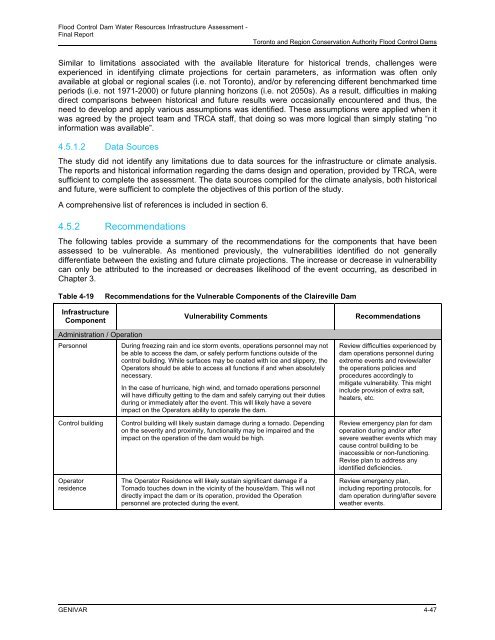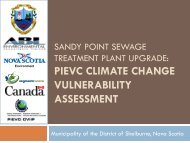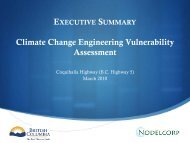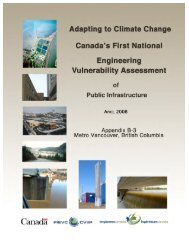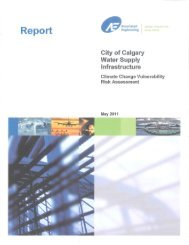Final Report - Vulnerability Committee
Final Report - Vulnerability Committee
Final Report - Vulnerability Committee
Create successful ePaper yourself
Turn your PDF publications into a flip-book with our unique Google optimized e-Paper software.
Flood Control Dam Water Resources Infrastructure Assessment -<strong>Final</strong> <strong>Report</strong>Toronto and Region Conservation Authority Flood Control DamsSimilar to limitations associated with the available literature for historical trends, challenges wereexperienced in identifying climate projections for certain parameters, as information was often onlyavailable at global or regional scales (i.e. not Toronto), and/or by referencing different benchmarked timeperiods (i.e. not 1971-2000) or future planning horizons (i.e. not 2050s). As a result, difficulties in makingdirect comparisons between historical and future results were occasionally encountered and thus, theneed to develop and apply various assumptions was identified. These assumptions were applied when itwas agreed by the project team and TRCA staff, that doing so was more logical than simply stating “noinformation was available”.4.5.1.2 Data SourcesThe study did not identify any limitations due to data sources for the infrastructure or climate analysis.The reports and historical information regarding the dams design and operation, provided by TRCA, weresufficient to complete the assessment. The data sources compiled for the climate analysis, both historicaland future, were sufficient to complete the objectives of this portion of the study.A comprehensive list of references is included in section 6.4.5.2 RecommendationsThe following tables provide a summary of the recommendations for the components that have beenassessed to be vulnerable. As mentioned previously, the vulnerabilities identified do not generallydifferentiate between the existing and future climate projections. The increase or decrease in vulnerabilitycan only be attributed to the increased or decreases likelihood of the event occurring, as described inChapter 3.Table 4-19Recommendations for the Vulnerable Components of the Claireville DamInfrastructureComponent<strong>Vulnerability</strong> CommentsRecommendationsAdministration / OperationPersonnelDuring freezing rain and ice storm events, operations personnel may notbe able to access the dam, or safely perform functions outside of thecontrol building. While surfaces may be coated with ice and slippery, theOperators should be able to access all functions if and when absolutelynecessary.In the case of hurricane, high wind, and tornado operations personnelwill have difficulty getting to the dam and safely carrying out their dutiesduring or immediately after the event. This will likely have a severeimpact on the Operators ability to operate the dam.Review difficulties experienced bydam operations personnel duringextreme events and review/alterthe operations policies andprocedures accordingly tomitigate vulnerability. This mightinclude provision of extra salt,heaters, etc.Control buildingOperatorresidenceControl building will likely sustain damage during a tornado. Dependingon the severity and proximity, functionality may be impaired and theimpact on the operation of the dam would be high.The Operator Residence will likely sustain significant damage if aTornado touches down in the vicinity of the house/dam. This will notdirectly impact the dam or its operation, provided the Operationpersonnel are protected during the event.Review emergency plan for damoperation during and/or aftersevere weather events which maycause control building to beinaccessible or non-functioning.Revise plan to address anyidentified deficiencies.Review emergency plan,including reporting protocols, fordam operation during/after severeweather events.GENIVAR 4-47


